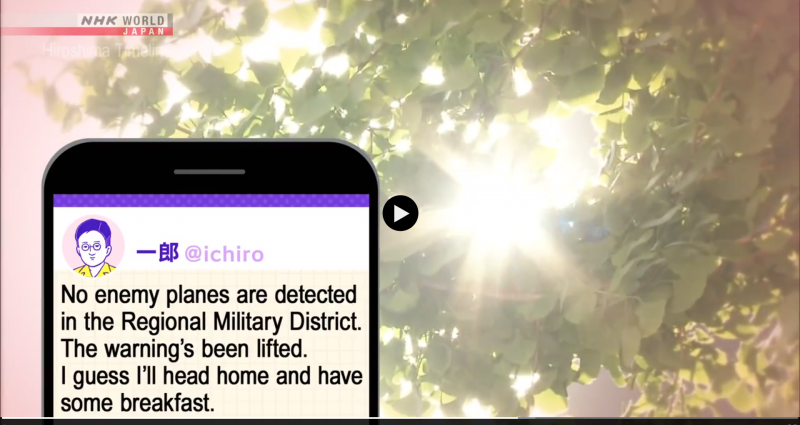Screencap from Hiroshima Timeline documentary on NHK on Demand.
To mark the 75th anniversary of the August 6, 1945 atomic bombing of Hiroshima, Japanese public broadcaster NHK has launched an innovative way to commemorate the world’s first use of nuclear weapons. The “What If They Had Social Media in 1945” (もし、75年前にSNSがあったら) project uses imaginary tweets based on the diary entries of three people who lived through the bombing of Hiroshima. Three Twitter accounts created for the project share a chronology of real-time tweets before, during and after the attack on Hiroshima.
★スタッフからのお知らせ★
やすこさんのツイートは、1945年に今井泰子さん(当時26)が書いた日記をもとにしています。
日記原文
8/1~7https://t.co/sU31lGnvN1
現代の広島に暮らす3人の女性が日記や資料を読み込み、関係者への聞き取りを行いながら作っています。#ひろしまタイムライン
— やすこ@ひろしまタイムライン (@nhk_1945yasuko) August 7, 2020
Yasuko’s tweets are taken from the 1945 diaries of Imai Yasuko, then 26 years old. Her diary entries (written in Japanese) from August 1 to August 7, 1945 can be found at the following link: https://www.nhk.or.jp/hibaku-blog/timeline/genbun/yasuko/434035.html
The diary entries came to be used for this project after three women who currently live in Hiroshima read them, and who then spread the word (about their importance).
Using three Twitter accounts, the Hiroshima Timeline project follows the lives in 1945 of Koichiro Osa (@nhk_1945ichiro), a 32-year-old reporter for the Chugoku Shimbun, Yasuko Imai (@nhk_1945yasuko), a 26-year-old homemaker pregnant with her first child, and Shunichiro Arai (@nhk_1945shun), 13, a junior high school student.
On August 6, 1945, in the final days of World War II, an American aircraft dropped an atomic bomb on the city of Hiroshima in western Japan. Up to 80,000 people—30% of the population of Hiroshima at that time—were killed instantly, and much of the city was destroyed. Three days later, on August 9, 1945, the city of Nagasaki experienced a similar attack.
For the Hiroshima Timeline project, three Twitter accounts were launched in late March, 2020, and used an “on-this-day” format to share observations and experiences of daily life from 75 years ago in the months leading up to the August 6, 1945 bombing.
In April, 1945, Shunichiro Arai had just entered middle school and was still learning how things worked.
【1945年4月26日】
今日は数学の時間に平板測量というものをした。この時間に僕は級長に、一番大切にしていた消しゴムを貸してあげた。数学が終わり返してくれと言うと、失くしたと言う。そういうきちんとしてない所も、皆にバカにされてしまう理由なのかもしれない。#ひろしまタイムライン— シュン@ひろしまタイムライン (@nhk_1945shun) April 26, 2020
(April 26, 1945)
Today in math class we learned about how to “survey area”. I gave the senior boy (head of class, 級長) my beloved eraser. While he said he would return it after math class, he said the eraser had “disappeared.” When he does careless things like this, it’s no wonder everyone says he’s an idiot.
According to an article in Tokyo Shimbun, the Hiroshima Timeline project was supervised by playwright Yaginuma Akinori. Ordinary citizens of Hiroshima of different ages and all walks of life participated in the project to help write the tweets. Participants read period newspaper articles and listened to stories by relatives in order to understand the lives, personalities, and sensibilities of the three people profiled in Hiroshima Timeline.
The tweets were published according to corresponding diary entries, but were rewritten in a more accessible contemporary vernacular, all with the goal of presenting what ordinary people thought and felt in during wartime.
The project also provides eyewitness accounts of the events of August 6, 1945, when an American aircraft dropped an atomic bomb on Hiroshima.
Reporter Koichiro Osa had just finished breakfast at his suburban home and was preparing to go to work when the bomb exploded. Left with a mouthful of dirt, first he checked to make sure his wife was safe, before venturing towards the city center.
【1945年8月6日】
あれはなんだ!
たけり狂う炎が、メリメリ、ゴーッと音を立てながら猿猴川の水を巻き上げている地獄だ。大焦熱地獄。#ひろしまタイムライン#もし75年前にSNSがあったら
— 一郎@ひろしまタイムライン (@nhk_1945ichiro) August 6, 2020
(August 6, 1945)
What was THAT? A blazing fire is roiling up the water of the Sarugawa River, growling with a splintering, crackling roar. It is hell on Earth. A great fiery hell.
Junior high school student Shunichiro Arai also lived in a suburb of Hiroshima, but had already been on his way to school when the bomb exploded. He experienced gruesome scenes as he navigated the ruins of the city, including a slowly marching column of badly wounded burn and blast victims.
【1945年8月6日】
顔が崩れている…目も鼻も崩れている
人、じゃない、あんなふうにはならない
人の形をしているが…#ひろしまタイムライン#もし75年前にSNSがあったら— シュン@ひろしまタイムライン (@nhk_1945shun) August 6, 2020
(August 6, 1945)
Faces totally destroyed, eyes, noses erased. These can’t possibly be people, even if they are human forms…
Homemaker Yasuko, whose husband was away from Hiroshima, serving as a conscript in the military, also survived the initial blast. The Hiroshima Timeline described her experience in a tweet that was shared thousands of times:
【1945年8月6日】
ものすごい光 地響き、家が揺れて 電気の傘やガラスがふきとんで#ひろしまタイムライン#もし75年前にSNSがあったら
— やすこ@ひろしまタイムライン (@nhk_1945yasuko) August 5, 2020
(August 6, 1945)
An incredible flash of light, a rumbling in the earth, the whole house sways, as lampshades scatter and window panes are blown out.
The sense of realism is so strong that a concerned reader asks about Yasuko’s unborn baby:
やすこさん!
お腹の赤ちゃんも大丈夫でしょうか— ひだまり工房
高円寺 RAVEL様で委託販売中 (@genkiniikirudh) August 5, 2020
Yasuko-san! Is your child in your tummy all right?
The Twitter account for Yasuko Imai was managed in part by Hiroshima resident Naori Fukuoka, whose grandparents experienced the bombing, and then had to live through devastation and hardship that persisted for years following the end of the war in August, 1945.
In an interview with Tokyo Shimbun, Fukuoka says:
8月6日に焼け野原になってたくさんの人が亡くなったことだけが原爆じゃない […] ずっと放射能の怖さを感じ、大勢の死傷者を見たトラウマ(心的外傷)と生きなくちゃいけない。原爆とは何だったか、私たちが考え出すのはこれからだと思う.
The atomic bomb not only killed all those people on a scorched field of earth field on August 6, 1945 […] Ever since that day we have all had to live in fear of radiation, and collectively we (in Hiroshima) have had to live with the trauma of witnessing mass death. When people wonder what happened on that day, from now on it is up to us to pass on that memory.
The Hiroshima Timeline project will continue to post tweets based on the diaries of the three eyewitnesses until the end of December, 2020.
The Hiroshima Timeline timeline documentary is available to watch online.











